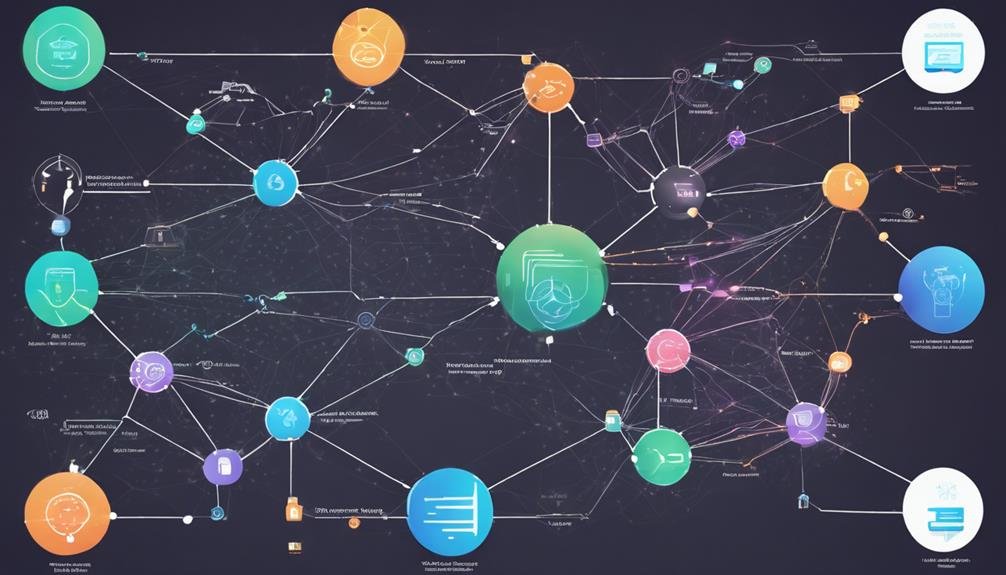Deploying DApps in DeFi comes with hefty costs due to network resource intricacies and token stakes in platforms like EOS. You must stake SYS tokens for CPU and Bandwidth, impacting deployment expenses. Smart contracts decide resource distribution based on tokens held. Limited resources such as RAM and CPU greatly affect costs. Utilizing the REX market can cut down expenses. Staking for network benefits requires token locking, influencing decentralization. By prioritizing resource access, DApp developers gain advantages. Optimizing resource usage is important for cost management. Understanding these factors sheds light on why costs are high.
Table of Contents
Brief Overview: Cost Of Deploying DApps In DeFi
- Staking SYS tokens for CPU and Network Bandwidth drives deployment costs.
- Limited resources like RAM impact expenses in DApp deployment.
- Network access privileges through token staking influence costs.
- Efficient resource management is crucial for cost control.
- Utilizing the REX market for resource leasing reduces deployment expenses.
EOS Network Resource Costs
When deploying DApps in DeFi, understanding EOS network resource costs is vital due to the controlled access based on staking ownership levels. DApp developers on the EOS main network acquire CPU and Network Bandwidth by staking SYS tokens, which involves smart contracts. These smart contracts dictate the allocation of resources based on the amount of SYS tokens staked, prioritizing users with higher ownership levels.
Limited resources such as RAM, CPU, and Network Bandwidth directly impact the costs associated with deploying DApps on EOS. Network Bandwidth, CPU, and RAM costs per EOS.IO Network are essential considerations when planning for DApp deployment. To mitigate these costs, developers can explore acquiring resources through the REX market on EOS, which offers a potential avenue for reducing expenses. By carefully managing and optimizing these network resources through staking and smart contracts, developers can navigate the complexities of deploying DApps on the EOS network more efficiently.
Staking for Network Access

Staking for network access in DeFi involves users locking up their tokens to gain certain privileges, like higher bandwidth and CPU usage. This process can influence the network’s decentralization, as those with more tokens have more control. Understanding the benefits and risks of staking is essential for users maneuvering the DeFi space.
Staking Benefits and Risks
By staking on the EOS network, users gain access to essential resources such as CPU and Network Bandwidth to support their DApp operations efficiently. This staking mechanism allows users to prioritize their access to network resources based on their ownership stake in SYS tokens. Staking is beneficial for DApp developers as it helps them acquire the necessary resources to run their applications smoothly.
Additionally, the REX market on EOS enables users to lease resources, reducing overall network access costs. However, there are risks involved in staking, such as the potential for fluctuations in token value and the lock-up period for staked tokens. Despite these risks, staking for network access is important in balancing resource availability and user demand on the EOS network. Staking can also help offset transaction fees, making it a valuable option for users seeking cost-effective network access.
Impact on Decentralization
Deploying DApps in DeFi with a focus on staking for network access can significantly impact the decentralization of the EOS network. Staking is vital to the EOS public blockchain to obtain CPU and network bandwidth resources. By staking, users with higher ownership gain priority in accessing these resources, potentially influencing network decentralization. DApp developers engage in staking SYS tokens to secure CPU and Network Bandwidth for their applications.
The EOS main network facilitates resource leasing through the REX market to alleviate costs. The scarcity of network resources like RAM, CPU, and Network Bandwidth on EOS directly affects the expenses associated with deploying DApps, underscoring the intricate relationship between staking, resource access, and network decentralization.
Limited Resource Factors

Limited resource factors such as RAM, CPU, and Network Bandwidth on the EOS network substantially impact the high costs associated with deploying DApps in DeFi. In the blockchain world, where efficiency is key, these resources are essential in determining developers’ expenses. The finite nature of these resources means that their availability directly affects the cost of deploying decentralized applications in the DeFi space.
As demand fluctuates and network conditions evolve, the costs of acquiring CPU and Network Bandwidth can vary considerably. To mitigate these expenses, developers must carefully plan their resource allocation strategies. Optimizing the usage of RAM, CPU, and Network Bandwidth becomes crucial to managing costs effectively. Understanding the dynamics of these limited resources is fundamental for DApp developers looking to navigate the complexities of deploying their applications within the DeFi ecosystem on the EOS network.
Acquiring Resources via SYS Tokens

Acquiring resources on the EOS network for deploying DApps involves staking SYS tokens to access essential CPU and Network Bandwidth resources. By staking SYS tokens, DApp developers secure the necessary resources like RAM, CPU, and Network Bandwidth, which are vital for their decentralized applications. This method of acquiring resources is a fundamental strategy for optimizing DApp deployment on the EOS network. Staking SYS tokens gives developers computational power and network capabilities to guarantee that their DApps run smoothly and efficiently. It gives developers a reliable infrastructure to support their decentralized applications effectively.
Staking SYS tokens is an integral part of the process for DApp developers looking to establish a strong foundation for their projects on the EOS network. This method enables developers to access the resources they need to bring their decentralized applications to life, setting the stage for successful deployment and operation within the DeFi ecosystem.
Leasing Resources in REX Market

To optimize resource management for your DApp deployment on the EOS network, consider engaging in the REX market to lease essential network resources. You can effectively minimize the costs of running decentralized applications by leasing resources in the REX market, such as CPU and Network Bandwidth. This market allows users to rent out excess EOS tokens in exchange for the resources required for DApp operations, enabling you to access additional resources without significant upfront investments.
Participating in the REX market offers the advantage of optimizing resource allocation and improving the efficiency of deploying DApps on the EOS network. This method not only aids in cost reduction but also guarantees that your DApp has the necessary resources to operate smoothly. By utilizing the REX market for leasing resources, you can manage gas fees effectively and enhance the overall performance of your decentralized application without incurring high expenses.
Calculating Costs on EOS

Calculating costs on EOS involves understanding transaction fees and managing resource allocation challenges. It’s essential to consider the impact of CPU congestion on transaction processing costs on the EOS main network. Planning and strategically overseeing your resource allocation can result in more cost-effective DApp deployment on EOS.
EOS Transaction Fees
When deploying DApps on EOS, understanding the EOS transaction fees is essential for accurately estimating the overall costs. Here are some key points to take into account:
- EOS network resource access is controlled by staking SYS tokens to prioritize users with higher ownership.
- DApp developers can acquire CPU and Network Bandwidth on EOS by staking SYS tokens.
- Costs on the EOS network include Network Bandwidth, CPU, RAM, and Account Acquisition costs.
Calculating costs on EOS involves estimating network bandwidth, CPU congestion, and RAM demand for DApp deployment. This process allows developers to budget effectively and optimize resource allocation for efficient DApp deployment on the EOS network. Understanding the transaction costs associated with EOS is critical in maneuvering the expenses of DeFi application development.
Resource Allocation Challenges
Understanding resource allocation challenges on EOS is essential for efficient DApp deployment in DeFi applications. On EOS, DApp developers must stake SYS tokens to access network resources like CPU and Network Bandwidth. The costs of deploying smart contracts on EOS include limited resources such as RAM, CPU, and Network Bandwidth. These resources have a direct impact on the expenses incurred during DApp deployment.
Proper resource allocation planning is critical for managing costs effectively on the EOS network. By staking SYS tokens, developers can guarantee they have the necessary resources to support their smart contracts and optimize their deployment in the DeFi space. Allocating resources wisely is key to handling the complexities of cost management in EOS DApp development.
Estimating Network Bandwidth

How are network bandwidth costs determined on EOS for deploying DApps in DeFi? Estimating network bandwidth expenses involves considering the amount of data transmitted in each transaction and the frequency of transactions. To dive deeper into this topic, let’s explore some key points:
- Network bandwidth costs on EOS are linked to the data size in each transaction.
- Calculating the frequency and size of transactions is important for estimating network bandwidth expenses accurately.
- DApp developers must factor in network bandwidth costs when planning their deployment in the DeFi space.
Efficient data management and transaction optimization are important in reducing network bandwidth expenses for DApp deployment. Understanding the formulas to calculate these costs is essential for developers to budget effectively and plan their DApp deployment strategies on EOS. By being mindful of network bandwidth expenses, developers can streamline their deployment process and improve cost-efficiency in the DeFi ecosystem.
Managing CPU Congestion

Proactive resource management is essential for DApp developers to navigate CPU congestion on the EOS main network effectively. When deploying decentralized applications, such as NFT marketplaces, it’s important to contemplate the impact of high CPU usage on transaction processing. The delays caused by CPU congestion can lead to performance issues and increased costs for executing smart contracts.
Balancing CPU resources becomes paramount in ensuring the smooth operation of DApps in a congested environment. Optimizing code efficiency and monitoring network congestion can help manage CPU costs effectively. By being mindful of CPU bandwidth availability and implementing proactive measures, developers can mitigate the risks associated with CPU congestion and enhance the overall performance of their decentralized applications on the EOS network. Stay vigilant and adapt your resource management techniques to the dynamic nature of CPU congestion to navigate the complexities of deploying DApps successfully in the DeFi ecosystem.
Optimizing RAM Demand

Efficiently managing data storage is essential for DApp developers looking to optimize RAM demand on the EOS network. When it comes to blockchain technology, optimizing RAM demand can be a game-changer. Here are some key strategies to help you achieve this:
- Utilize decentralized storage: Offloading storage to decentralized services like IPFS can notably reduce RAM usage and cut costs.
- Plan resource allocation: Early resource allocation planning can assist in optimizing RAM demand, ensuring efficient use of resources, and reducing overall deployment expenses.
- Monitor market conditions: Acquiring RAM on EOS involves fluctuating costs with market conditions and DApp requirements. Staying informed about these changes can help you make cost-effective decisions regarding RAM usage.
Frequently Asked Questions
How Much Does It Cost to Deploy a Dapp?
Deploying a DApp involves network bandwidth, CPU usage, and RAM allocation costs. Factors like blockchain choice (Ethereum, Binance Smart Chain, EOS) and resource needs affect expenses. To understand the cost analysis, consider these variables.
Why Are Dapps Not Popular?
DApp adoption faces hurdles due to high deployment costs on networks like EOS. Acquiring resources by staking SYS tokens leads to initial expenses. Limited availability and fluctuating prices contribute to the challenge. Planning is crucial.
What Are the Disadvantages of Dapps?
When considering DApp Security, remember potential drawbacks like vulnerabilities in smart contracts, user data privacy concerns, and the risk of hacks. Prioritize robust security measures to protect users and maintain trust.
How Much Does It Cost to Deploy an ETH Contract?
Deploying an ETH contract incurs deployment fees based on gas prices and contract complexity. Costs range from $100 to $200 due to network congestion. Use gas estimators to predict costs accurately. Miners need incentives to process transactions.
Conclusion
Deploying dapps in DeFi on the EOS network can be costly due to the various resource factors. From staking for network access to managing CPU congestion, the expenses can add up quickly. By understanding the different ways to acquire and optimize resources, developers can better navigate the costs of deploying their decentralized applications. It’s like trying to juggle multiple balls in the air while walking a tightrope – challenging, but with careful planning, it can be done.




